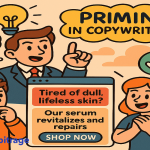This blog tells content writers and marketing strategists how to leverage buyer readiness stages and reciprocity to build a deadly effective MOFU email. It provides analysis and actionable frameworks to start building lead-generating MOFU emails right now.
Introduction
The other day, I came across a long LinkedIn post by a startup founder, lamenting about how his ads generated high-quality but his marketing team could not convert them. This was nothing new; a lot of new brands and businesses suffer from good quality leads not converting and attribute it to a failure of their teams, ads, and landing pages.
They couldn’t be more wrong. The ads were fine, but more often than not, the MOFU (Middle of Funnel) part was shaky.
It was impossible to try to sell through BOFU (Bottom of Funnel) and TOFU (Top of Funnel) alone.
You know what’s harder than selling to a stranger?
Selling to someone who almost trusts you.
They’ve clicked the ad.
They have watched half of your webinar and maybe liked a sponsored post. But now, they’re thinking. “Do I need this?” “Is this worth it?” “What’s in it for me?”
This is when you send the MOFU email. This is your one shot to tip them over. According to a recent study, MOFU emails can boost conversion rates by up to 25% compared to TOFU emails alone.
Take a look at the impact of MOFU emails on conversion rates.
But MOFU is tricky. If done wrong, you’ll sound like another pushy salesperson.
Done right? You build so much value that they sell themselves on you.
Let’s learn how to do that.
What does MOFU even mean?
Every marketing funnel has three stages:
TOFU (Top of Funnel) is for awareness. “Hey, you have this problem.”
MOFU (Middle of Funnel) is for evaluation. “Here’s why we are your best solution.”
BOFU (Bottom of Funnel) is for conversion. “Let’s do this. Enrol. Buy. Sign up.”
Sounds simple, right? But most Indian brands fumble here, because either they sell too hard and come off desperate, or they don’t sell at all and waste precious attention.
In India, where trust is often built through community validation and price comparisons, MOFU emails must feel personal and value-driven to stand out.
What you need is strategic warmth and psychology. Specifically: Buyer Readiness Stages + Reciprocity Bias.
But what are these, and how do you leverage them?
The 2 psychological levers you must pull
1. Buyer readiness stages
At MOFU, the buyer is already aware of their problem and is comparing options.
You need to help them conclude, “This is the best bet for me.”
To do that, you need to:
- Show proof.
- Reduce risk.
- Frame your offer as a logical next step.
You’re not convincing them to buy. You’re helping them decide.
2. Reciprocity bias
You must have heard the popular phrase “give and take”. MOFU funnels are all about reciprocity. You need to give before you ask.
Give so much value, they feel compelled to say “yes.”This is where Indian brands like GrowthSchool win.
Their emails include:
- Free checklists
- Mini-case studies
- Insider frameworks
- One actionable idea
When you give more, you sell more—without sounding salesy.
Want to know what the ideal MOFU template looks like?
Take a peek.
Template of a great MOFU email
Let’s break it down.
Framework: the “Give-Then-Guide” structure
Step 1: Start with a value nugget: Do you need a framework? Here’s one. Do you need a checklist? Take this, etc.
Step 2: Tie it to your offer: Do you need more? Take this product.
Step 3: Make a low-friction ask: Here are the people who benefited! If you don’t like it, here’s the full refund.
This way, the email feels like help. Not a pitch.
Here are some high-converting Indian MOFU email templates you can use right away.
Template 1: GrowthSchool-Style Value Drop
Subject: What 8-figure creators do that most Indian content writers don’t
Hi [First name],
Most Indian content creators burn out because they focus on content volume, not systems.
Here’s a simple framework that 8-figure creators like Raj Shamani and Ankur Warikoo use:
3R Content System
- Raw → Capture unpolished ideas from life
- Refine → Use hooks and structure to polish
- Repurpose → Break down into carousels, reels, and posts
Want to build your own 3R system and start attracting inbound leads like clockwork?
Join our 5-Day Creator Bootcamp (starts this Sunday)
You’ll learn how to build a system that brings leads to you—without dancing on Reels.
Cheers,
[Your Name]
Why it works:
Starts with insight. Gives a ready-to-use framework. Then connects it to the bootcamp. Low-pressure, high-value.
Template 2: WhiteHat Jr-Style Parent Psychology
Subject: What if your kid could learn AI before college?
Hi [First name],
Most schools still teach computers like it’s 2005.
But companies like Google are already hiring 14-year-olds for AI internships.
Here’s what one of our students, Aarav (Age 12), built last month:
A chess bot that plays like Magnus Carlsen—trained using Python + OpenAI.
Want to see how?
👉 Download Aarav’s project demo here
If you want your child to not just use tech but build it, our Junior AI Creator course is a great place to start.
Enroll here (New batch starts Monday)
Cheers,
Team WhiteHat Jr
Why it works:
Anchors to aspiration and proof. Gives before asks. Taps into parent FOMO (Fear Of Missing Out) without feeling pushy.
Template 3: B2B Agency-Style Proof + Ask
Subject: How we got 117 B2B leads in 14 days (case study inside)
Hi [First name],
Most B2B founders struggle with lead gen because their cold emails sound… well, cold.
Last month, we helped a fintech client generate 117 qualified leads in 2 weeks using this:
The Nudge Sequence
- Email 1: A surprising insight about the prospect’s industry
- Email 2: A breakdown of what they’re losing by not acting
- Email 3: A 60-second video showing what they could be doing
Want to see the actual sequence?
👉 Download the case study here
If you’re curious how this could work for you, let’s hop on a 15-minute call.
Book here
Best,
[Your Name]
Founder, [Agency Name]
Why it works:
Results + Breakdown + Easy CTA. Feels educational. Creates curiosity. Converts without friction.
Template 4: Storytelling Nudge
Subject: The mistake that cost Priya ₹50,000
Hi [First Name],
Priya, a small business owner, missed a key SEO trend last year. Result? Her competitor got 3x more traffic and ₹50,000 in sales.
Don’t make the same mistake. Here’s a quick tip: Use long-tail keywords to boost your site’s ranking.
Want the full strategy?
👉 Join our 3-Day SEO Masterclass (starts next week).
Learn the tricks Priya missed and grow your business.
Cheers,
[Your Name]
Why it works: A relatable story creates an emotional connection, and the soft CTA invites action without pressure.
What you should remember
- MOFU emails are not full-blown pitches. They’re educational nudges.
- Use buyer readiness stages to show why you’re the best choice.
- Use reciprocity to give more than you ask.
- Follow the “Give-Then-Guide” framework.
Just change the brand name + CTA and use any of these to start your MOFU email campaign with a bang.
Conclusion
You have the plug-and-play templates; start building your swipe file.
And when you write your next MOFU email, remember:
Don’t try to convince. Help them conclude. Try this out today and let me know how it went in the comment box below!
FAQs
1. How do I know if an email should be TOFU or MOFU?
Ask: “Has this person interacted with the brand before?”
- If they don’t know the brand or the problem → it’s TOFU (you educate, build awareness).
- If they’re already aware of the problem but haven’t acted → it’s MOFU (you guide them toward action)
A practical trick: check where the lead came from.
- Leads from webinars, newsletters, or organic search = MOFU
- Leads from cold Facebook ads or generic freebies = TOFU
Sending TOFU-style educational emails to a MOFU lead is like giving an intro class to someone ready to enroll.
2. What kind of CTA should a MOFU email have?
A MOFU CTA should be low-stakes and value-first. You’re not selling the final product — you’re inviting the reader to take one small next step.
Some great MOFU CTA examples:
- “Download the free case study”
- “See how XYZ founder got 4x ROI”
- “Watch the 3-min behind-the-scenes video”
- “Book a free discovery call”
- “Reply with ‘Interested’ and I’ll send you the deck.”
These CTAs feel consultative, not salesy. The goal is to build momentum, not close the deal right away.
3. How do I stop my MOFU emails from sounding like a blog post?
MOFU emails should feel personal and solution-oriented, not like an info dump.
Use this structure to keep it tight:
- Problem: Mention a specific pain your audience already recognizes.
- Proof: Share a short win, success story, or stat that builds trust.
- Process: Briefly explain how the result was achieved.
- Path forward: Invite them to take the next step with a soft CTA.
Example:
“Most Indian edtech founders struggle with high CAC. We helped one reduce theirs by 42% just by fixing this landing page mistake. Want the breakdown? Hit reply and I’ll send it.”
Short. Valuable. Focused.
4. Can I use free AI tools to write MOFU emails that don’t sound robotic?
Yes — but think of AI as your idea partner, not a replacement for your writing brain.
Here’s how to use free tools smartly:
- Use ChatGPT or Gemini to help structure the email, rewrite sentences, or brainstorm CTAs.
- Use Perplexity.ai to research how similar brands structure their MOFU content.
- Use Grammarly to tighten tone and catch repetitive phrases.
Prompt example for ChatGPT:
“Write a friendly MOFU email for a B2B edtech startup that solves X problem. Include one success story, one insight, and a soft CTA to watch a video. Keep the tone consultative.”
You’ll still need to rewrite at least 30% to add voice, cultural cues, and storytelling. But AI gets you 70% of the way faster.
5. How do I know if my MOFU email is ready to send?
Run it through this simple checklist:
- Does it address a real, known problem your reader is already aware of?
- Does it offer something new — a case study, framework, checklist, or insider tip?
- Is there a proof element — stat, result, or mini-story?
- Is the CTA frictionless — something easy to say yes to?
- Does it feel like a helpful nudge, not a pitch?
If the answer is yes to all five, it’s ready.
- If even one is missing, tweak it. In MOFU, timing and tone are everything.







 Allow notifications
Allow notifications
